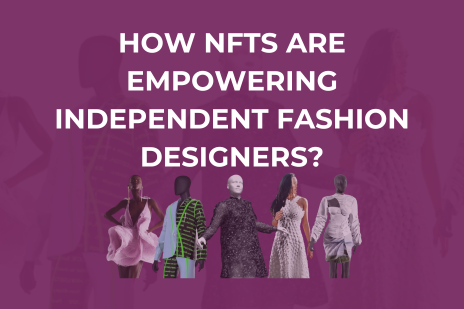How NFTs are Empowering Independent Fashion Designers?

The fashion industry, with its ever-evolving trends and styles, has traditionally been dominated by major brands and established designers. However, the advent of blockchain technology and the rise of Non-Fungible Tokens (NFTs) are beginning to disrupt this status quo. NFTs, unique digital assets that represent ownership of a specific item or piece of content, have taken the world by storm, impacting various industries from art to music, and now fashion. This blog post explores how NFTs are empowering independent fashion designers, allowing them to reach global audiences and monetize their creations in unprecedented ways.
What are NFTs?
Non-Fungible Tokens, or NFTs, are digital assets that are stored on a blockchain. Unlike cryptocurrencies such as Bitcoin or Ethereum, which are fungible and can be exchanged on a one-to-one basis, NFTs are unique and cannot be replaced with something else. Each NFT represents a specific item or piece of content, such as digital art, music, or in this case, fashion designs. The blockchain technology underlying NFTs ensures their authenticity and ownership, providing a new way for creators to sell and distribute their work.
The Intersection of NFTs and Fashion
The fashion industry has always been at the forefront of innovation, constantly exploring new ways to engage with audiences and showcase creativity. With the rise of digital fashion and virtual reality, it was only a matter of time before NFTs found their way into this space. Early adopters in the fashion industry have already started experimenting with NFTs, creating digital clothing items, virtual fashion shows, and exclusive collections. These pioneers are paving the way for a new era where fashion and technology intersect in exciting and groundbreaking ways.
How Independent Designers Leverage NFTs
One of the most significant advantages of NFTs for independent fashion designers is the ability to reach global audiences. Traditionally, emerging designers have faced numerous barriers in gaining international recognition, from the high costs of participating in fashion weeks to the challenges of breaking into established markets. 
NFTs, however, provide a platform for designers to showcase their work to a worldwide audience without the need for physical presence.
Take, for example, the case of digital fashion designer The Fabricant, who sold a virtual dress for $9,500 in 2019. This sale highlighted the potential of digital fashion and NFTs, demonstrating how designers could monetize their creations in a digital space. By leveraging NFT platforms such as OpenSea, Rarible, and Foundation, independent designers can sell their fashion items directly to consumers, bypassing traditional retail channels and retaining a higher percentage of their earnings.
In addition to direct sales, NFTs also offer the opportunity for designers to earn royalties on secondary sales. This means that whenever an NFT is resold, the original creator receives a percentage of the sale price. This model ensures that designers continue to benefit from the increasing value of their creations over time, providing a sustainable income stream.
Creating exclusive collections is another way that independent designers can leverage NFTs. Limited edition digital fashion items can create a sense of scarcity and exclusivity, driving demand and increasing the value of the designs. Collaborations and partnerships with other artists, designers, or even brands can further enhance the appeal of these collections, attracting a broader audience and fostering a sense of community.
Challenges and Considerations
While the potential of NFTs in the fashion industry is vast, there are also challenges and considerations that designers need to be aware of. One of the main barriers is the technical knowledge required to navigate the world of blockchain and NFTs. Understanding how to create, manage, and sell NFTs can be daunting for those unfamiliar with the technology. Additionally, setting up and managing digital wallets, which are necessary for storing and transacting NFTs, can be a complex process.
Market volatility is another concern. The value of cryptocurrencies, which are often used to buy and sell NFTs, can fluctuate significantly. This volatility can impact the pricing and demand for NFT fashion items, making it difficult for designers to predict their earnings. Furthermore, the NFT market itself is relatively new and untested, with uncertain long-term demand for digital fashion items.
Legal and ethical issues also need to be considered. Intellectual property rights are a critical aspect of the fashion industry, and designers must ensure that their digital creations are protected. Additionally, there are environmental concerns related to the energy consumption of blockchain networks. The process of minting and transacting NFTs can be energy-intensive, contributing to the carbon footprint of the fashion industry.
Future Prospects of NFTs in Fashion
Despite these challenges, the future prospects of NFTs in the fashion industry are promising. Innovative trends such as virtual reality and augmented reality fashion are already emerging, with designers creating digital garments that can be worn in virtual environments. Wearable tech and digital fashion are likely to become more prevalent, offering new opportunities for creativity and expression.
In the long term, NFTs have the potential to become mainstream in the fashion industry. As technology evolves and more designers and consumers become familiar with NFTs, we can expect to see a greater adoption of digital fashion items. Independent designers will continue to benefit from the ability to reach global audiences, monetize their creations, and build engaged communities around their work.
Conclusion
NFTs are revolutionizing the fashion industry, offering independent designers unprecedented opportunities to showcase their creativity, reach new audiences, and generate income. While there are challenges to navigate, the potential of NFTs to empower designers and transform the fashion landscape is undeniable. As the industry continues to evolve, it is essential for designers to stay informed and explore the possibilities that NFTs present.
For a more in-depth analysis of how independent designers leverage NFTs to reach global audiences and monetize their creations, check out our detailed Guide here.

